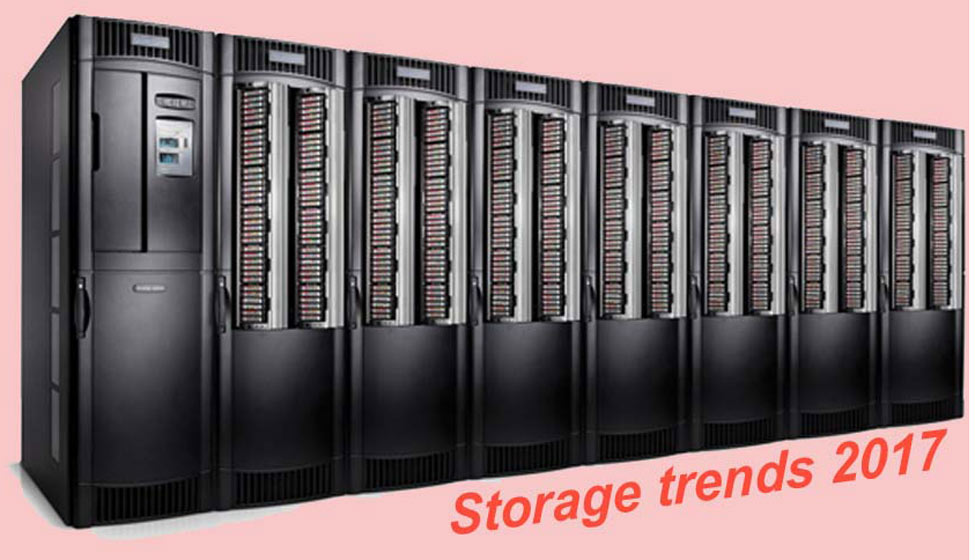The new year promises lots of business for those providing enterprise and personal storage solutions. Why? Because the increasing preference for ultra high definition or 4K video, both by enterprises and individuals is going to trigger off a huge storage demand. This is just one trend that's 'in store' in 2017.
Jim Simon, Senior Director of Marketing, Asia Pacific and Japan for global storage leader Quantum, has compiled other potential developments in the storage business, that we have drawn up to compile this checklist of Magnificent Seven trends.
1. AI and self-drive cars
By 2020, ten million cars on the road are expected to have self-driving features reflecting the continuing move toward an IoT-based world and advances in artificial intelligence (AI). Designing autonomous vehicles requires the ability to harness massive amounts of camera and sensor data, analyze it and apply AI technology. The more data it has, the smarter it can become.
In the past, one of the biggest hurdles for AI was processing power, but now storage has become the limiting factor. Traditional, general-purpose storage solutions can’t keep up with the performance requirements or provide the long-term data retention and access capabilities needed at an affordable price point. As a result, more enterprises will turn to specialized storage and data management solutions that can meet these challenges.
2. Corporate Video
They used to say, a picture is worth a thousand words. If so a moving picture is worth ten thousand.Video is taking on a much larger role in the activities and processes of organizations... for enhancing teaching and guarding against malpractice claims in hospitals, improving quality control in manufacturing facilities and analyzing buyer behavior in retail stores. Companies will also continue to make video a bigger part of their training and service initiatives, just as YouTube videos are replacing written manuals in the consumer space. In fact, while the written word is far from obsolete, in many areas video will increasingly become the de facto communication platform. All of this will require greater collaboration between IT and line-of-business owners to ensure they have the storage and data management infrastructure that can support a video-dominant world as efficiently and cost-effectively as possible.
3. Object storage
Object storage, which means a hierarchy-free method of storing data, typically used in the cloud, has extreme scalability and durability capabilities, providing large-scale data volumes at a lower price point than primary disk storage . Object storage has played a foundational role in public cloud services for some time now, but expectations that it would become the dominant technology for large-scale data retention have not been borne out. In many cases, users are realizing that an intelligent file system and the latest tape storage technology can provide equivalent, or even better, performance at a lower cost. Moving forward, therefore, enterprises will primarily deploy object storage as the basis for their private clouds, with tape maintaining its role as the optimal technology for long-term, low-cost archive of large-scale unstructured data.
4. Tape versus Disk
The role of tape in backup has continued to decline, but tape as a storage medium is far from dead. The ever-increasing volume and value of unstructured data has brought greater attention to the importance of preserving and protecting this data in a robust, low-cost archive, and, as noted above, tape is still the best technology for long-term retention, with significant advances in performance, capacity and ecosystem integration being introduced every few years. That’s why organizations dealing with massive amounts of unstructured data – in genomics, academic research, video surveillance and entertainment, to name just a few examples – will continue to make tape a key part of their storage infrastructure and why even enterprises that have vowed to move away from tape will find themselves reversing course. At the same time, as large public cloud providers expand their role as major storage players and compete to drive down pricing, they will increase their reliance on tape to make their business models work – yes, although hidden behind the clouds, tape has long been used in this realm because the economics simply can’t be beat.
5. Public and Private cloud data
IDC forecasts that IT infrastructure spending for public and private cloud will increase at compound annual growth rates of approximately 19% and 10%, respectively, from 2015 to 2020. As more data moves to the public cloud, we can expect to see greater adoption of a dual-cloud vendor policy – just as enterprises maintain at least two sources for critical infrastructure components, companies are recognizing the need to extend this approach to the cloud services they buy. A key challenge, however, will be linking their public clouds – and private clouds – together so they can seamlessly provision cloud resources and move workloads among the clouds. Organizations will increasingly look for storage and data management solutions that are not only multi-site but also multi-cloud.
6. 4K and all that

4K video is not new. Cinemas began projecting in 4K in 2011, and Netflix began streaming some shows in 4K two years ago. Indian Dish TV providers have provided 4K intermittently mostly for sports broadcasts. However, while much of the media and entertainment industry has moved to 4K, adoption of 4K in other markets has been relatively slow. One of the main reasons why is that enterprises are still struggling to figure out how they can manage this type of data. 4K video presents challenges in terms of not only much larger file sizes but also much higher data With video taking on a much larger role in the enterprise (as noted in prediction no. 2), organizations will increasingly need to address this gap. The key to doing so without replacing the entire storage infrastructure will be leveraging high-performance solutions optimized for video that can integrate into the existing infrastructure.
7. Supercomputers need super storage
With the advent of clustered computing becoming common in nearly every enterprise, organizations are rapidly creating more data that they want to use strategically to make better and faster business decisions – for example, regarding new investments, more efficient operations, higher product quality or improved customer service. As a result, enterprises are increasingly looking to the high-performance computing or supercomputer industry for best practices and technologies to provide the performance, capacity and data management capabilities needed at this new scale. However, it’s essential that the HPC industry move beyond its traditional focus on binary data and account for the tremendous growth of richer unstructured data.





